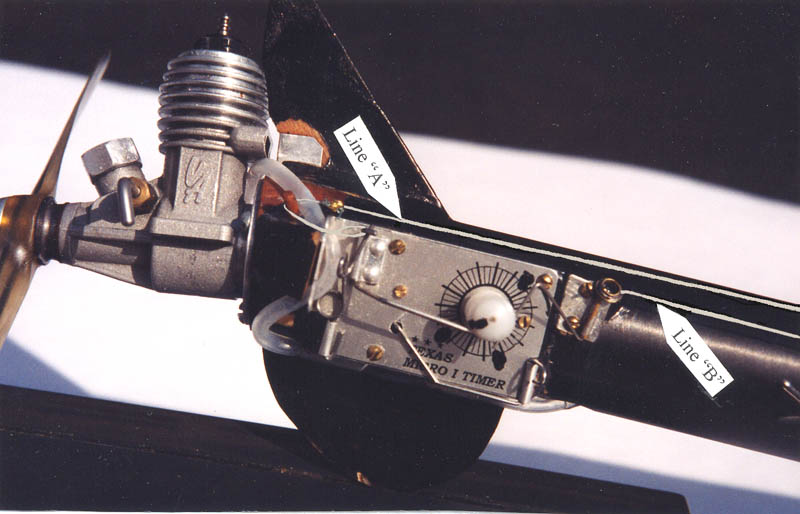
VIT WITH THE MICRO I
An Application for 1/2A and F1J
Information taken and expanded upon from an article by Gil Morris that originally appeared in the 2000 edition of the National Free Flight Society Symposium. (pages 5 and 6) The article was titled "All Strings No Levers VIT". The reader is referred to this article for in depth information on the entire application. This information is published with the permission of the author. Photo supplied by author.

This application has been successfully flown in 1/2A AMA as well as F1J for a number of years. The author reports that in some cases where the plane will achieve terminal velocity before the engine run is over (i.e. F1J), a bunt may not be needed for a good transition, and the stabilizer is held in the power position for several seconds before being moved to the glide position.
Line "A" is the bunt line which is released by the fuel line pinch-off lever (note the peg by the fuel line which is used to change the line direction so the loop in the line can hooked onto the timer). Line "B" is the glide line. It is released by the lever which is added to the fuselage. The opposite end of the lever runs in the same "groove" of the timer scroll as the engine kill wire. (In this case, glide begins about one quarter turn of the scroll after engine kill and bunt). Since the timer is turning at about 4 seconds per revolution, the delay is about 1 second. Note: the timer runs in the counterclockwise direction.
Lines "A" and "B" 15 lb. monofilament or braided nylon. (lines have been digitally enhanced from the original photo for better visibility). The lines have some "stretch" and create their own tension.
A shallow notch has been made in the tab of the faceplate that sticks out of the timer and Line "A" sits in this notch. The line is terminated in a loop that is fit over the wire which snaps to the left to release the mousetrap when the opposite end is released from the scroll threads. The rather pronounced hook in the wire where the loop is placed has been reduced somewhat to allow Line "A" to release properly.
The glide delay can be altered by changing the location where the lever interfaces with the scroll threads. A delay of about 0.25 to 2 seconds can be readily achieved.
Note from Texas Timers: Although the author has had excellent results with this application of the MICRO I, we would be very wary of a similar use in larger models do the higher loads placed on the timer.
ABOUT THE AUTHOR
Gil Morris of Columbus, OH has been an avid and accomplished modeler for over 70 years. Some notable designs of his include the Kerswap, Toothpicks, Matchsticks, and Twigs. Gil is also well known for his flapper designs for F1C. He has represented the US two times in International FAI competition. The latest in 2002 where he will compete in Hungary.